Motivation key to company effectiveness in learning organisations
DOI:
https://doi.org/10.18531/sme.vol.10.no.1.pp.62-76Kulcsszavak:
Extrinsic and intrinsic motivators, autotelic activity, emotional intelligence, clarifying needsAbsztrakt
The aim of this study is to show the importance of building up effective motivation systems in organisations by clearly defining the substantive organisational and individual needs and by implementing high-level harmonisation between them. At the beginning of the 21st century, the most important features of the global market environment are the complexity, the instability, and the uncertainty. In such a business environment, the quick understanding of the changes and the ability of giving rapid and professional strategic answers to them become a key element in forming the efficiency of any business organisations. Such a company flexibility must be based on conscious human resource management activity founded on the attentive application of knowledge management tools so that it can effectively exploit the opportunities offered by the high-level cognition of emotional intelligence.
One of the key elements of such a competent HR management work is to build up a company motivation system that serves the goals of both the company and the employees perfectly. This paper introduces the results of an extensive questionnaire survey aiming to collect reliable and comprehensive information about real intrinsic motivations of people so that a higher level of harmonisation between companies and their employees’ needs can be implemented by building up better organisational motivation systems.
Hivatkozások
Bilal, A. – Ahmad, W. – Jan, M. F. – Huseynov, R. – Nagy, H. (2021): How Women’s Trans-formational Leadership Induces Employees’ Innovative Behaviour Through Trust and Con-nectivity: A Sequential Mediation Model. Global Business Review, 25(3), ISBN: 0972-1509 0973-0664, DOI: https://doi.org/10.1177/097215092098276
Price, R. (2023): Why strategic plans don’t work … and what to do about it. https://www.reliableplant.com/Read/15167/why-strategic-plans-don't-work-what-to-do-about-it
Shujahat, M. – Hussain, S. – Javed, S – Malik, M. I. – Thurasamy, R. – Ali, J. (2017): Strategic management model with lens of knowledge management and competitive intelligence: A re-view approach. VINE Journal of Information and Knowledge Management Systems, https://www.emerald.com/insight/content/doi/10.1108/VJIKMS-06-2016-0035/full/html
Abuhamdeh, S. (2020): Investigating the „flow” Experience: Key Conceptual and Operational Issues. CONCEPTUAL ANALYSIS article, Front. Psychol., 13 February 2020; Sec. Per-formance Science, 11, https://doi.org/10.3389/fpsyg.2020.00158
Csehné Papp, I. – Káposzta, J. – Nagy, H. (2017): A regionális egyenlőtlenségek munkaerő-piaci manifesztálódása. Comitatus: Önkormányzati Szemle, 66–77.
Koenig, M. E. D. (2018): What is KM? Knowledge Management Explained. KM World, https://www.kmworld.com/About/What_is_Knowledge_Management
Deckers, L. (2018): Motivation. Taylor & Francis Ltd.
Jackson, A. (2021): Higher Motivation. XULON PR.
Káposzta, J. – Illés, B. – Nagy, H. (2017): Examination of impact of economic policy on quality of life in regions of some European countries with global perspective. Engineering For Rural Development, 16(1), 236–241. DOI: https://doi.org/10.22616/erdev2017.16.n045
Nagy, H. – Káposzta, J. (2017): A magyarországi régiók humán erőforrás potenciáljának vizsgá-lata az Európa 2020 stratégia tükrében. Közép-Európai Közlemények, 10(1), 86–98.
Casalino, N. – Nagy, H. – Borin, B. (2018): Strategic and organizational effects of environmen-tal regulation on operational processes of sustainable MSEs. Law and Economics Yearly Re-view, 7(2). 365–388.
Joy, M. M. (2019): Leadership & Motivation 3.0 - A new dimension on workplace motivation. Researchgate; Researchgate, https://www.researchgate.net/publication/341867083_Leadership_Motivation_30_-_A_new_dimension_on_workplace_motivation
Cherry, K. (2022a): What is self-determination theory?. https://www.verywellmind.com/what-is-self-determination-theory-2795387
Ryan, R. M., – Deci, E. L. (2018): Self-Determination Theory. Guilford Publications.
Cherry, K. (2022b): Extrinsic vs. intrinsic motivation – What is the difference?. https://www.verywellmind.com/differences-between-extrinsic-and-intrinsic-motivation-2795384
Bhasin, H. (2021): What is a learning organisation? Peter Senge’s 5 Disciplines of Learning, https://www.marketing91.com/learning-organization/
Sinek, S. – Mead, D. – Docker, P. (2018): Találd meg a miérted. HVG Könyvek, Budapest.
Sinek, S. (2020): The Infinite Game. Penguin Books Ltd.
Hassan, N. –Noor, M. N. M. – Hussin, N. (2017): Knowledge Transfer Practice in Organiza-tion. International Journal of Academic Research in Business and Social Sciences, 7(8)., DOI: https://doi.org/10.6007/IJARBSS/v7-i8/3291
Wasserman, T. (2020): Motivation, Effort, and the Neural Network Model. Springer Nature Switzerland AG.
Letöltések
Megjelent
Folyóirat szám
Rovat
License
Copyright (c) 2023 Marczell-Szilágyi Eszter , Magyar Tímea

This work is licensed under a Creative Commons Attribution-NonCommercial-NoDerivatives 4.0 International License.
A folyóirat Open Access (Gold). Cikkeire a Creative Commons 4.0 standard licenc alábbi típusa vonatkozik: CC-BY-NC-ND-4.0. Ennek értelmében a mű szabadon másolható, terjeszthető, bemutatható és előadható, azonban nem használható fel kereskedelmi célokra (NC), továbbá nem módosítható és nem készíthető belőle átdolgozás, származékos mű (ND). A licenc alapján a szerző vagy a jogosult által meghatározott módon fel kell tüntetni a szerző nevét és a szerzői mű címét (BY).






